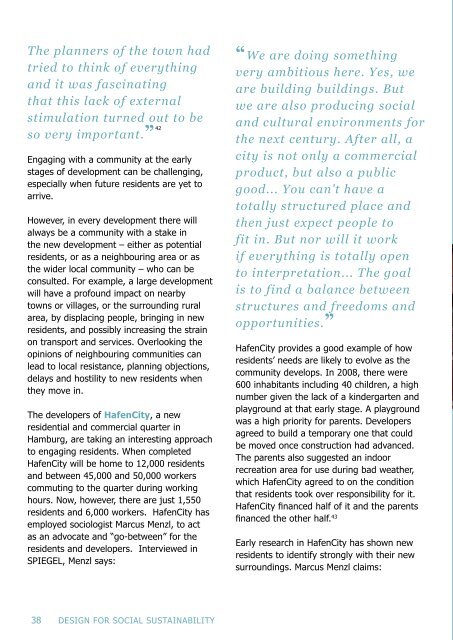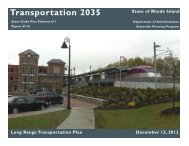Design for Social Sustainability â Saffron Woodcraft, 2010
Design for Social Sustainability â Saffron Woodcraft, 2010
Design for Social Sustainability â Saffron Woodcraft, 2010
Create successful ePaper yourself
Turn your PDF publications into a flip-book with our unique Google optimized e-Paper software.
The planners of the town had<br />
tried to think of everything<br />
and it was fascinating<br />
that this lack of external<br />
stimulation turned out to be<br />
so very important.” 42<br />
Engaging with a community at the early<br />
stages of development can be challenging,<br />
especially when future residents are yet to<br />
arrive.<br />
However, in every development there will<br />
always be a community with a stake in<br />
the new development – either as potential<br />
residents, or as a neighbouring area or as<br />
the wider local community – who can be<br />
consulted. For example, a large development<br />
will have a profound impact on nearby<br />
towns or villages, or the surrounding rural<br />
area, by displacing people, bringing in new<br />
residents, and possibly increasing the strain<br />
on transport and services. Overlooking the<br />
opinions of neighbouring communities can<br />
lead to local resistance, planning objections,<br />
delays and hostility to new residents when<br />
they move in.<br />
The developers of HafenCity, a new<br />
residential and commercial quarter in<br />
Hamburg, are taking an interesting approach<br />
to engaging residents. When completed<br />
HafenCity will be home to 12,000 residents<br />
and between 45,000 and 50,000 workers<br />
commuting to the quarter during working<br />
hours. Now, however, there are just 1,550<br />
residents and 6,000 workers. HafenCity has<br />
employed sociologist Marcus Menzl, to act<br />
as an advocate and “go-between” <strong>for</strong> the<br />
residents and developers. Interviewed in<br />
SPIEGEL, Menzl says:<br />
“We are doing something<br />
very ambitious here. Yes, we<br />
are building buildings. But<br />
we are also producing social<br />
and cultural environments <strong>for</strong><br />
the next century. After all, a<br />
city is not only a commercial<br />
product, but also a public<br />
good... You can’t have a<br />
totally structured place and<br />
then just expect people to<br />
fit in. But nor will it work<br />
if everything is totally open<br />
to interpretation... The goal<br />
is to find a balance between<br />
structures and freedoms and<br />
opportunities.”<br />
HafenCity provides a good example of how<br />
residents’ needs are likely to evolve as the<br />
community develops. In 2008, there were<br />
600 inhabitants including 40 children, a high<br />
number given the lack of a kindergarten and<br />
playground at that early stage. A playground<br />
was a high priority <strong>for</strong> parents. Developers<br />
agreed to build a temporary one that could<br />
be moved once construction had advanced.<br />
The parents also suggested an indoor<br />
recreation area <strong>for</strong> use during bad weather,<br />
which HafenCity agreed to on the condition<br />
that residents took over responsibility <strong>for</strong> it.<br />
HafenCity financed half of it and the parents<br />
financed the other half. 43<br />
Early research in HafenCity has shown new<br />
residents to identify strongly with their new<br />
surroundings. Marcus Menzl claims:<br />
“That sort of emotional<br />
connection usually only<br />
comes with time. But they<br />
[residents] seem to have<br />
identified with HafenCity<br />
very quickly and they want to<br />
support the philosophy. You<br />
cannot build a neighborly<br />
feeling ... but I think that<br />
architecture can help<br />
certain processes and hinder<br />
others.” 44<br />
12. HafenCity, Hamburg, Germany<br />
Another example of the consequences of<br />
social sustainability methodologies can be<br />
drawn from a case study in Mumbai, India.<br />
Qualitative research carried out in 2009<br />
on the sustainability and trans<strong>for</strong>mational<br />
impact of the relocation of pavement dwellers<br />
showed that a community-led relocation<br />
process in which pavement dwellers were<br />
re-housed through a highly participatory<br />
process (i.e. having a say in the selection<br />
of the relocation site, the design of the<br />
built environment, and structures created<br />
<strong>for</strong> community governance) has been<br />
demonstrably more successful than traditional<br />
state-led relocation processes that lack<br />
participation and consideration of how the<br />
newly relocated communities might settle<br />
together and thrive. 45<br />
A growing body of research supports the<br />
assertion that community and neighbourhood<br />
empowerment – giving residents the<br />
opportunity to take part in collective activities<br />
that influence the areas they live in –<br />
contribute to the wellbeing of residents and<br />
communities.<br />
A report from the Local Wellbeing Project<br />
– a partnership between Local Government<br />
Improvement and Development, the Young<br />
Foundation, the London School<br />
of Economics and three local<br />
authorities (Manchester, South<br />
Tyneside and Hert<strong>for</strong>dshire) –<br />
argued that: wellbeing is higher<br />
in areas where residents can<br />
influence decisions affecting<br />
their neighbourhood; wellbeing<br />
is higher among people who<br />
have regular contact with their<br />
neighbours, and that wellbeing is<br />
higher in areas where residents<br />
have the confidence to exercise<br />
control over local circumstances.<br />
This study found three key<br />
benefits of empowerment<br />
that directly contribute to wellbeing: that<br />
it creates opportunities <strong>for</strong> residents to<br />
influence decisions, facilitates contact<br />
between neighbours, and builds residents’<br />
confidence to control local circumstances. 46<br />
As communities become established and<br />
social networks develop, both <strong>for</strong>mal and<br />
in<strong>for</strong>mal groups will <strong>for</strong>m. In<strong>for</strong>mal groups<br />
will include local activists coming together,<br />
often to <strong>for</strong>m campaign groups based<br />
on particular life experiences or interests<br />
(especially toddlers groups and faith<br />
38 DESIGN FOR SOCIAL SUSTAINABILITY<br />
VOICE & INFLUENCE 39
















